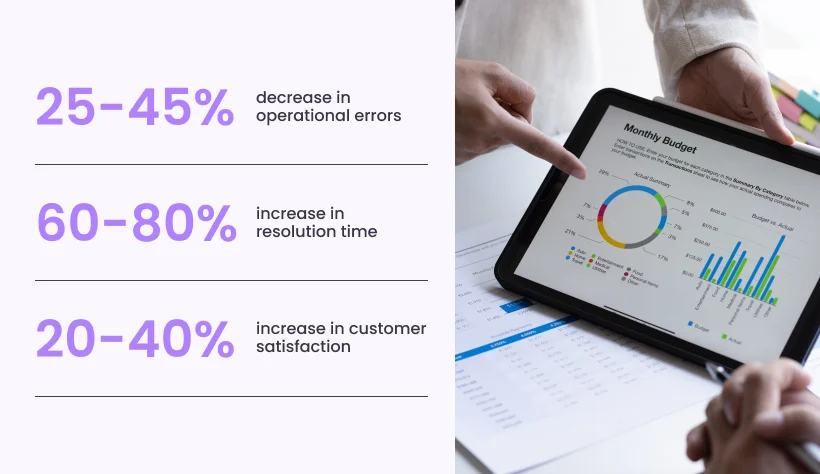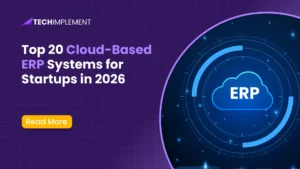
Predictive vs Diagnostic Analytics: What Really Works?
October 23, 2025 . 11 min readOrganizations and companies have access to more data than at any point in history, but data is only valuable when it is used to generate clear, actionable insight. There are two ways analytics help make better data-driven decisions: Each type of analytics answers separate questions, and together they can help a team move from simply reacting to situations to proactively planning and making smarter decisions.
According to ZipDo, a May 2025 article drawing on research from Deloitte, 72% of companies believe they can use analytics reports to improve customer experience. Companies that are data-driven are five times more likely to make decisions that are both faster and better. In today’s digital world, analytics isn’t optional; it’s a decisive competitive edge.
Understanding Business Analytics in Context
Business analytics allows raw data to be transformed into actionable insights and more informed, data-driven decisions. It allows organizations to monitor performance, analyze the root causes of trends, and later decide when to use that information by applying validated statistical techniques or professional, visually compelling methods of reports.
There are four types of business analytics, distinct from one another:
- Descriptive: What happened?
This summarizes performance, or what happened in the past, in dashboards, reports, or key metric formats. - Diagnostic: Why did it happen?
This differentiates itself from a descriptive analysis in that this analysis explores causes and relationships using correlation analysis, segmentation, or pattern detection. - Predictive: What will happen?
Predictive analysis utilizes trends, statistical or other qualitative models, or even machine learning, to estimate or predict the likelihood of a future outcome or probability. - Prescriptive: What should we do?
Prescriptive analysis recommends a course of action based on insights derived from any of the previous analytics and predictive probabilities, often to optimize a business outcome.
What Is Diagnostic Analytics? Understanding Why It Happened
Diagnostic analytics allows organizations to understand why something happened. It goes beyond just describing outcomes to identify the drivers and relationships that produce those outcomes, which makes it a great tool for groups to identify problems, generate adjustments, and make decisions based on data.
Core Functions
Root-cause analysis: Uncover the true reason for an outcome (or failure).
Drill-down and segmentation:Take a deep dive into different sizes of data to uncover insights you never noticed before.
Pattern and anomaly detection: Discover patterns to alert and detect that an event is occurring that brings unusual trends or deviations no one is looking at.
Key Techniques
- Correlation and data mining reveal that your variables may be linked.
- Log, cohort, and event analysis to recognize user or process behavior over time.
- Anomaly detection reveals that operations are not operating normally and are inconsistent in operations.
Example
Using diagnostic analytics to further investigate the increase in customer churn during Q2 would determine if the increase was due to the pricing strategy and change, a product with issues, or fixing the targeting for the Q2 campaign, and receive specific answers from data once again.
Proven Impact
Assuming your organization is an adequate size for typical reporting criteria, your organization should realize:
- 25-45% decrease in operational errors
- 60-80% increase in resolution time
- 20-40% increase in customer satisfaction

EasyData
These evidence-based improvements are a strong indicator of how diagnostic analytics supports business intelligence to support decision making through deeper understanding of “why it happened.”
What Is Predictive Analytics? Anticipating What’s Next
Predictive analytics offers the ability to predict future events through advanced predictive modeling and machine learning techniques from historical and real-time data. Predictive analytics empowers businesses to predict trends, quantify risks, and make proactive, data-driven decisions rather than reactive decisions.
Core Functions
- Forecasting demand or revenue: Predictive models estimate future sales, inventory requirements, and financial projections.
- Risk scoring and scenario modeling: Use historical and behavioral data to evaluate the risk potential and run scenarios for likely outcomes.
- Opportunity prioritization: Leverage predictive insights to recognize leads or customers with the highest probability to convert.
Key Techniques
- Regression and time series forecasting to identify patterns and model seasonal trends.
- Machine learning models, including classification or ensemble methods, for better accuracy of predictions and predictive modeling automation.
Example: A company may leverage predictive analytics to estimate sales volume for the next quarter by looking at seasonality, historical trends, and marketing expenses, allowing for smarter planning and resource allocation.
Impact at a Glance
Organizations leveraging predictive analytics have achieved measurable performance gains:
- 67% adoption rate across industries (Scholink Research)
- 76% higher forecast accuracy through advanced predictive modeling
- 73% faster decision-making enabled by real-time machine learning insights
- Up to 60% lower operational costs
- A projected global market value of USD 22.2 billion by 2025 (DemandSage)
What is the difference between predictive and diagnostic analytics?
Both predictive and diagnostic analytics play vital roles in data-driven decision-making, yet they serve distinct purposes. In the context of predictive vs diagnostic analytics, diagnostic analytics focuses on explaining why something happened in the past, while predictive analytics looks ahead to forecast what is likely to happen next. When combined, they create a powerful framework for generating actionable business insights that improve strategy and performance.
Analytics Comparison: Diagnostic vs Predictive
| Feature | Diagnostic Analytics | Predictive Analytics |
|---|---|---|
| Purpose | Understand past outcomes and uncover underlying causes. | Forecast future outcomes and trends to support proactive planning. |
| Question Answered | “Why did it happen?” | “What is likely to happen?” |
| Techniques Used | Data mining, correlation analysis, anomaly detection. | Regression, time-series forecasting, predictive modeling, and machine learning. |
| Data Type | Primarily historical data. | Historical plus real-time data for greater accuracy. |
| Outcome | Provides insights and explanations to improve current operations. | Delivers predictions and probabilities to guide future decisions. |
In essence, the analytics comparison between diagnostic and predictive analytics highlights two complementary approaches: one helps you learn from the past, and the other prepares you for the future. Together, predictive vs diagnostic analytics empower organizations to extract meaningful business insights that drive smarter, evidence-based decisions.
When to Use Diagnostic Analytics
Diagnostic analytics is most useful when you want to determine why something happened and to understand a process or the root causes that created the outcomes. This is ideal for business performance analysis to assess data for discovery, properly analyze data, understand outcomes, and improve processes to avoid the same issue from being repeated, etc.
Use it for:
- Customer churn analysis to determine the reasons behind customer loss.
- Operational bottlenecks to discover and resolve work slowdowns.
- Campaign performance review to assess which marketing works and why.
By examining hidden patterns in the data, diagnostic analytics will ultimately allow teams to remedy problems promptly and support well-informed decisions to make improvements.
When to Use Predictive Analytics
Utilize predictive analytics when you wish to better understand what is likely to happen next and act in advance of the outcome happening. It is the foundation of forecasting models. It enables leaders to make proactive and insight-driven decisions.
Use it for:
- Demand forecasting: Anticipating future demand to help understand future sales and plan resources.
- Risk management: Identifying possible risks to prevent disruption and damage performance.
- Predictive maintenance: Identify the potential for equipment to fail by alerting you to early warning indicators.
The use cases for predictive analytics put organizations in the position to be ahead of change and convert insights into intelligent, forward-looking strategies.
Can Predictive and Diagnostic Analytics Work Together?
Yes, combining predictive and diagnostic analytics creates a powerful synergy. Diagnostic analytics identifies why events occurred by uncovering root causes, while predictive analytics forecasts what is likely to happen next. When used together, they provide a complete picture of business performance, enabling smarter and more strategic decisions.
Example in Practice: A marketing team can use diagnostic analytics to understand why a campaign underperformed and then apply predictive analytics to forecast which customer segments are most likely to respond to future campaigns. This combination improves marketing ROI and ensures efficient resource allocation.
Benefits of Integration:
- Supports data synergy by connecting past insights with future predictions.
- Enhance decision-making with a 360-degree view of business performance.
- Enables seamless integrated analytics within platforms like Microsoft Dynamics 365 , Power BI, or custom analytics solutions.
By combining predictive and diagnostic analytics, organizations turn raw data into actionable intelligence, achieving operational efficiency and strategic foresight.
Real-World Examples of Predictive and Diagnostic Analytics
Healthcare
Healthcare Diagnostic Analytics: In a 2024 study at UC San Diego Health, an AI algorithm monitoring over 150 patient variables reduced sepsis mortality by 17%. UC San Diego Health+1 Predictive Analytics: In the same context, the tool flagged sepsis risk hours before traditional detection, improving timely intervention.
Retail
Diagnostic Analytics: A 2024 study in retail found that AI-powered demand-forecasting reduced stock-outs by around 10% of annual revenue losses due to previously unanticipated supply-chain gaps. SuperAGI+1 Predictive Analytics: According to research from 2024, AI-driven forecasting improved inventory accuracy, enabling better product availability and reduced over-stock risk.
Manufacturing
Manufacturing Diagnostic Analytics: A 2024 case at BA Glass’s Avintes plant analysed sensor data from a furnace to detect early signs of failure in real-time. Frontiers Predictive Analytics: That same 2024 study showed predictive maintenance analytics led to significant reductions in unplanned downtime and better operational reliability
By combining diagnostic and predictive analytics, organizations gain actionable insights that enhance decision-making, efficiency, and outcomes across industries.
Common Challenges and How to Overcome Them
Implementing predictive and diagnostic analytics brings value but comes with challenges:
- Data Quality: Data that is either incomplete or inaccurate diminishes the value of insights.
Resolution: Institutions should employ governance, data-cleaning pipelines, and maintain continuous monitoring for all data sources. - Model Accuracy & Bias:Models may be biased or inaccurate.
Resolution: Retrain models continually, ensure diverse data from multiple populations to inform the model, and provide checks for bias within the model. - System Integration:Disconnected systems limit analytics efficiency.
Resolution: The institution should use APIs, connectors, or one platform that integrates analytics functions to push data for analytic tasks. - Skill Gaps: Lack of expertise slows adoption.
Resolution: Upskill employees, hire experts, or contract the analytics undertaking with users outside the organization.
Insight: 47% of organizations cite data quality issues and 63% face integration challenges in predictive analytics.
By addressing these data challenges and improving data quality and integration, organizations can unlock the full potential of analytics for smarter, data-driven decisions.
Choosing the Right Approach for Your Business
Selecting the right analytics approach depends on business readiness and the quality of available data. A structured assessment ensures actionable insights.
Analytics Framework:
- Descriptive Analytics: Review past performance through reports and dashboards.
- Diagnostic Analytics: Understand the reasons behind outcomes.
- Predictive Analytics: Anticipate future trends and risks.
- Prescriptive Analytics: Recommend the best course of action based on insights.
Decision Checklist:
- Business Goal: Clearly define what decisions or outcomes you aim to support.
- Data Readiness: Ensure data is reliable, complete, and structured for analysis.
- Tools & Technology: Confirm that analytics platforms are in place to handle your chosen methods.
Following this approach helps align analytics with business objectives, supports your analytics maturity, and ensures decisions are driven by relevant, actionable insights.
How Tech Implement Helps Businesses with Analytics
With deep expertise in Microsoft Dynamics 365 and advanced analytics solutions, Tech Implement helps organizations unlock the full potential of their data and drive intelligent decision-making.
- Centralized Data: Integrate CRM and ERP systems for accurate, real-time reporting.
- Diagnostic Insights: Create dashboards that quickly uncover root causes and patterns.
- Predictive Analytics: Deploy models to forecast trends and embed actionable insights into daily workflows.
- Automation & Governance: Streamline data pipelines and maintain reliable, high-quality models.
By combining expertise in data visualization, integration, and automation, Tech Implement empowers businesses to make smarter, faster, and more informed decisions.
Conclusion
Diagnostic analytics help businesses understand why past outcomes occurred, while predictive analytics anticipate what is likely to happen next. Together, they provide deeper insights and strategic foresights that drive smarter decisions and sustainable business growth.
FAQs
Clean and structure historical data, use diagnostic insights to define predictive features, run a pilot to measure accuracy and ROI, and scale successful models to move from understanding past outcomes to anticipating future trends.
Low-quality or incomplete data, rapidly changing business conditions, and unmonitored model bias reduce accuracy. Continuous monitoring, updating datasets, and retraining models help maintain reliable predictions.
Yes. Start with focused use cases, use cloud-based tools, or partner with analytics experts to gain actionable insights without heavy investment, enabling smarter, data-driven decisions.
Integrate through APIs, connectors, or embedding models directly into workflows and dashboards, so predictions drive real-time, actionable decisions across operations.
AI automates feature discovery, improve model accuracy, accelerate insights, and make advanced analytics accessible, helping organizations shift from reactive to proactive decision-making.
Author Insights
Miley Johnson is a Technical Content Creator at Tech Implement, passionate about making complex technology easy to understand. She specializes in turning technical jargon into clear, engaging content that helps businesses and professionals navigate CRM and ERP solutions with confidence. With a strong attention to detail and a love for storytelling, Miley creates content that not only informs but also connects with the audience. Her goal is to simplify technology and make it more accessible for everyone.
Ready to bring your project to life?
Schedule a Meeting


